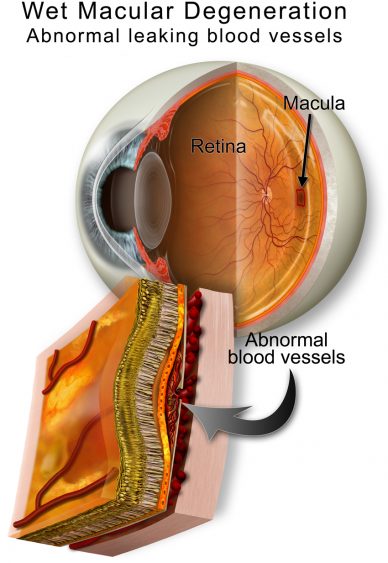Unfortunately, there is no permanent “cure” for age-related macular degeneration (AMD), however, there is an effective treatment for the most aggressive form, wet (neovascular) AMD, which can save your eyesight, if started and maintained in a timely manner.
How is Wet Macular Degeneration Treated?
In cases of wet AMD, a protein called Vascular Endothelial Growth Factor (VEGF) is released by the retina, which triggers the abnormal growth of blood vessels resulting in bleeding and/or fluid leakage under the retina. This results in rapid vision distortion and loss.
There is now an effective medication that can block the action of VEGF, commonly referred to as anti-VEGF.
When this anti-VEGF medication is delivered by an intravitreal injection (injection into the vitreous chamber of the eye), it reduces the leakage from abnormal blood vessels, and can stabilise or even improve vision.
Early detection and intervention are crucial in the effective treatment of wet AMD and unfortunately the treatment is only effective for a limited period of time.
Patients will usually need to have intravitreal injections with anti-VEGF on a regular basis depending on their response to treatment.

What to Expect with Intravitreal Injections
Intravitreal injections are the most common and effective treatment for wet AMD, and involve a medication being injected into the vitreous cavity of the eye.
The entire injection process usually takes just a few minutes once the eye is numbed.
- 1. The thought of an injection to the eye is a worrying one, but if done right, the patient should not see the needle or feel any pain.
- 2. First, your eye and eyelid will be numbed with drops, a gel or numbing injection, and cleaned with a yellow iodine solution.
- 3. You’ll be asked to look in a particular direction, depending on the location site for your injection, and your doctor will hold your eyelid open while the injection takes place. This will only take a couple of seconds.
- 4. You might feel some pressure or discomfort, but you should not feel pain. As the medicine is distributed into the vitreous cavity inside your eye, you might see some wavy lines or floaters.
- 5. After the injection, your eye will be cleaned and flushed with a lubricating solution.
- 6. In the following couple of days, you may have some grittiness, which can be alleviated with simple lubricants. There may also be localized redness appearing in the white of the eye, known as a subconjunctival haemorrhage, which then becomes green or yellow like a bruise before resolving completely.
- 7. Your specialist will speak with you about any serious complications that you should be aware of post-injection, and you should contact your specialist as soon as possible if you experience any signs or symptoms associated with these complications.
Macular Degeneration Injection FAQs
Common questions about macular degeneration injections include:
Your eye will be numbed before the injection and while you may feel a little pressure, you should not experience any pain.
Your specialist will hold your eyelid open, and you will be asked to look in a particular direction while the injection takes place.
The very small needle used during an intravitreal injection will be put into the white part of your eye (sclera) and you will not be able to see it during the injection.
The frequency of injections will depend upon how your case of wet AMD responds to the anti-VEGF medication. This can be as often as every few weeks or as far apart as every few months.
Specialist Treatment for Macular Degeneration
Our specialists are available at three convenient clinic locations across the Gold Coast, fully equipped for the diagnosis, treatment and management of all eye-related conditions.